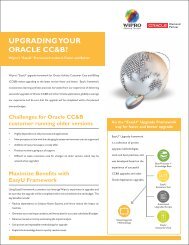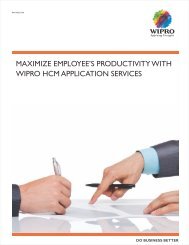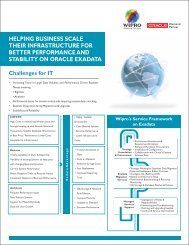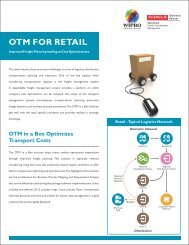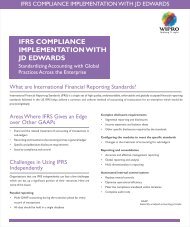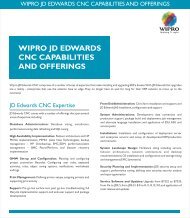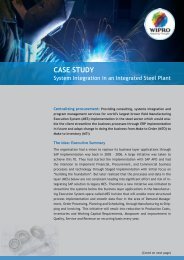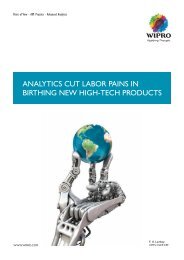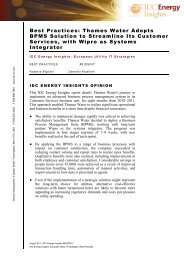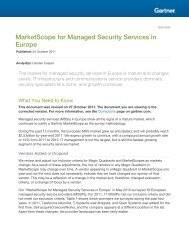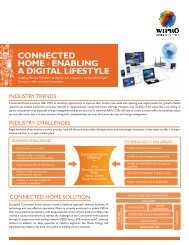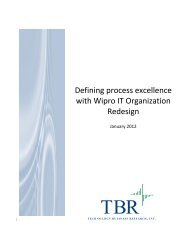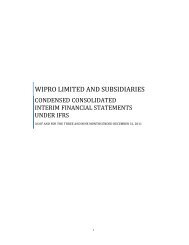White Paper Template
White Paper Template
White Paper Template
Create successful ePaper yourself
Turn your PDF publications into a flip-book with our unique Google optimized e-Paper software.
Contents<br />
Introduction<br />
Why GRC Assessment<br />
Benefits of Cloud computing and Problem Statement<br />
Key Speculations & Problems faced by Cloud service user’s in Today’s time<br />
Threats, Vulnerabilities and related Risks<br />
Wipro Recommendation: GRC Framework for Cloud Computing<br />
GRC Framework<br />
Identified GRC Domains<br />
Assessment Tools- Solution.<br />
Wipro Recommendation: Top 4 Action Points to Strengthen Cloud Computing<br />
Security.<br />
Conclusion<br />
Acronyms<br />
References<br />
About the Authors<br />
About Wipro Consulting Services<br />
2
Introduction<br />
“Do more with less” is key objective for CXO for current financial year. The IT industry has been waiting<br />
for the next big thing and two words that rock the world is “Cloud Computing”. Because Cloud<br />
computing promised the means to achieve the objective. All though a lot of speculation has been going<br />
around with respect to security, privacy, governance, compliance, etc related issues within Cloud<br />
computing.<br />
As per the latest report by Gartner on „Top End user Predictions 2010‟‟. Key predictions summarized<br />
below are related to more and more use of Web access and cloud computing services in future leading to<br />
increased threats, vulnerabilities and risks to cloud computing security.<br />
By 2012, 20% of businesses will own no IT assets.<br />
By 2012, India-centric IT service companies will represent 20% of the leading cloud aggregators in<br />
the market.<br />
By 2012, Face book will become the hub for social networks integration and Web socialization.<br />
By 2014, most IT business cases will include carbon remediation costs.<br />
In 2012, 60% of a new PC‟s total life greenhouse gas emissions will have occurred before the user<br />
first turns the machine on.<br />
Internet marketing will be regulated by 2015, controlling more than $250 billion in Internet<br />
marketing spending worldwide.<br />
By 2014, more than three billion of the world‟s adult population will be able to transact<br />
electronically via mobile and Internet technology.<br />
By 2015, context will be as influential to mobile consumer services and relationships as search<br />
engines are to the Web.<br />
By 2013, mobile phones will overtake PCs as the most common Web access device worldwide.<br />
In recent past there have been many cases where a customer/client has faced major problems in accessing<br />
their own data due to server crash down or legal action against a cloud provider. Google faced a server<br />
outage for its mail service which led to a downtime of more than 100 minutes during which many Gmail<br />
users were unable to access their emails. A similar problem but in a different format was faced by Pirate<br />
Bay customers, when their systems were seized by the police they couldn‟t find their own websites /or<br />
data storage in place. Many of them who were not even involved with The Pirate Bay, lost their servers<br />
and systems and still have not gotten them back near two years later.<br />
Another area where Cloud Computing is facing hurdles is privacy and security the basic data or business<br />
information which is housed on a Cloud Service providers Server. There has been speculation‟s that<br />
although there is a cost benefit to outsource the entire IT Infrastructure and focus on one‟s own Core<br />
Competencies, but due to number of incidences the reliability to use it has still not come in majority of<br />
the IT Sector all over the globe. Wipro has come up with a Governance, Risk and Compliance (GRC)<br />
approach for Cloud Computing in order to tackle these issues and provide a unified solution for Cloud<br />
Service providers as well as its Customers.<br />
It can be clearly seen that although Cloud Computing is a very promising concept of technology, but there<br />
is still a long way to go for security, governance, risk and compliance related issues to be formalized and<br />
streamlined with the changing times in the IT industry.<br />
Wipro consulting services- Governance, Risk Management & Compliance practice have worked on the<br />
main concern areas of Cloud Computing – Governance, Risk & Compliance (GRC) Assessment and<br />
therefore have developed a “GRC Approach for Cloud Computing” .Its main focus is to list Threats,<br />
vulnerabilities, Risks that are associated to all three parts of Cloud Computing – Infrastructure as a<br />
Service (IaaS), Platform as a Service (Paas) & Software as a Service (Saas) and suggest controls which have<br />
been assimilated from the best practices prevailing in the Industry. These controls have been placed in<br />
order to mitigate the risks in Cloud Computing and provide unified approach to handle and manage them.
This <strong>White</strong> paper targets on the GRC aspect of Cloud Computing and suggests methodology and<br />
techniques to tackle cloud security related problems in detail in the subsequent sections. Any organization<br />
who is a cloud consumer or a cloud service provider may adopt this approach to ensure cloud security in<br />
a holistic manner.<br />
Benefits of Cloud computing & Problem Statement<br />
The objective of providing Cloud security to Cloud Computing is to justify the benefits associated to it.<br />
But the speculations revolving around Cloud computing can‟t be neglected as it ranges from basic data<br />
level security when it is stored at a third party location to Compliance or Security practice & Legislation.<br />
There are series of changes taking place internally and externally for a business environment leading to<br />
increased level of complexity of threats and risks arising around it. However there are compelling benefits<br />
to Cloud Computing:<br />
Change from capital expenditure(CAPEX) to Consumption based Operational expenditure<br />
Go green with device & location Independence<br />
Scalability and flexibility without compromising customer value<br />
Although these benefits offered by Cloud Computing are quite tempting for any organization as it has lead<br />
to the basic characteristics which have always been important: Cost Savings, High Availability, Flexibility,<br />
Agility & Efficiency.<br />
The Problem comes in when we want to see the basic three pillars of Information Security Confidentiality,<br />
Integrity and Availability to be in place. We understand the cost of security solutions we deploy, but what<br />
about the cost of inaction, the cost of security failures to the business or the cost to the business of too<br />
much security? As we are moving from Language of Security to Language of Risk we need to evaluate<br />
these aspects and act accordingly.<br />
Key speculations & problems faced by Cloud users in today’s time<br />
Due to lack of proper understanding and application of related controls to ensure certain aspects of<br />
Confidentiality, Availability & Integrity (CIA) there have been lot of speculations and apprehensions for<br />
many Businesses‟ to use Cloud Computing as a tool for all the benefits mentioned above. As we are<br />
moving from securing IT Infrastructure to securing Information in terms of Confidentiality, Integrity &<br />
Availability we need to address the following concerns related to Information Security.<br />
Threats, Vulnerabilities & Risks:<br />
Potential Loss of Control of Data once it is stored on Third Party Cloud.<br />
Possible leakage of Data & Confidential Information.<br />
Privacy Management.<br />
Availability, Reliability & Longevity of Cloud & Service providers.<br />
Rapidly growing volumes of Data.<br />
Stable level of Abstraction, Virtualization and Encapsulation.<br />
4
New Threat Environments.<br />
Adherence to Legal Laws and Regulations varying across the globe for Information Security.<br />
Intellectual Property Issues: Ownership and right to use.<br />
Ensure secure operations.<br />
These are the major concerns which are enveloping everyone‟s thought process in today‟s time when it<br />
comes to Cloud Computing and Wipro Consulting Service-Governance Risk & Compliance has kept these<br />
into focus in order to develop the GRC Approach for Cloud Computing.<br />
Wipro Recommendation: Holistic Approach to cloud security- Governance,<br />
Risk Management & Compliance framework<br />
Wipro Consulting Service-Governance, Risk & Compliance Practice (WCS-GRC) has developed GRC<br />
Assessment framework for Cloud Computing which is based upon the Industry Best practices and<br />
research on key Information security related issues over the years. This proven framework is helping<br />
Cloud Service providers, assessing cloud services and also checking self-readiness for cloud services.<br />
Overall WCS-GRC approach is a single unified set of controls with continuous monitoring process whose<br />
objective is to secure the Cloud in a step by step approach. This Activity begins with classifying &<br />
categorizing assets followed by identifying & selecting Control objectives and related controls to mitigate<br />
threat, vulnerabilities and risks to these assets. These control requirements may be mandated by<br />
government regulation such as Sarbanes-Oxley, by industry standards such as the International<br />
Organization for Standardization (ISO) 27000 series and the Payment Card Industry data security<br />
standard (PCI DSS), and even by organization own security best practices. These controls are mapped<br />
with individual standards and redundant or not applicable controls are removed accordingly. The Control<br />
framework so established is prioritized according to identified assets, risks and vulnerabilities.<br />
The Figure-1: resulting common Wipro’s control GRC framework Assessment becomes Framework the basis of your for Securing Enterprise GRC Cloud-A program Six and Step<br />
represents the minimum set of security controls Approach<br />
needed to meet organization security and compliance<br />
5
needs. WCS-GRC has designed a 6 step approach to evaluate and assess the maturity, IT risks related to<br />
the services offered by cloud service provider under IaaS, PaaS, SaaS or EaaS with respect to Governance,<br />
Risk & Compliance. The same approach can be adopted by organizations for self assessment of their<br />
readiness to use the Cloud services from GRC Perspective.<br />
This framework has been very carefully crafted and designed by referring knowledge base and expertise of<br />
GRC for Information security over the years and Industry Standards & Best Practices namely ISO 27001,<br />
ISO 31000, CobiT 4.1, ITIL v3.0, OCTAVE, NIST SP 800-30, SOX, SAS-70 and ISF.<br />
There are few standards that can be directly combined and used to establish this<br />
security framework for Cloud Computing:<br />
SAS 70 Audit (Statement of Auditing Standards).<br />
Combined IS0 27001, ISO 31000, CobiT 4.1, ITIL v3.0 & NIST-SP 800 30 security best practices for<br />
GRC Maturity Assessment and IT Risk Assessment.<br />
Wipro Identified GRC Domains:<br />
For performing the GRC Assessment of the cloud services or for the readiness assessment, WCS-GRC<br />
has identified the following GRC domains in order to cover all information security related aspects for<br />
Cloud Computing and the GRC assessment is done across all these identified domains.<br />
Governance & Enterprise Risk Management<br />
Compliance & IS Audits<br />
Legal regulations and laws<br />
Electronic Discovery (e-discovery)<br />
Information Lifecycle Management<br />
Identity & Access Management<br />
Policy Management<br />
Data Protection<br />
Encryption & Key Management<br />
Data Centers Management<br />
Incident Management<br />
Storage level Security<br />
Virtualization Security<br />
These domains have been identified in order to understand the different areas that are involved with<br />
Cloud Computing Security in a holistic way. These are the key domains which are critical to any<br />
organization looking for an overall security which ensures that the data residing in public or private cloud<br />
is safe<br />
6
Wipro’s GRC Assessment Tools used for Cloud security readiness for cloud<br />
consumers and cloud service provider GRC Maturity assessment:<br />
“GRC Assessment Tools” from this part of the service includes a statement of applicability that<br />
documents the organization common control framework as well as a list of highly critical controls that<br />
require priority during follow-on assessments and remediation efforts.<br />
This Statement of Applicability tool has been constructed for mapping different control standards and the<br />
GRC domains in order to do as-Is analysis and suggest missing controls. Key industry standards for<br />
Information Security used for it namely are ISO 27001, CobiT 4.1 and ITIL v3.0. These standards have not<br />
been used as it is in the manner they are already available; instead they have been handpicked accordingly<br />
specifically for Cloud Computing security.<br />
Figure 2: Statement of Applicability<br />
The first step in the GRC Assessment is to perform the Maturity Assessment of the cloud services or<br />
readiness of the user to consume the cloud service, either ways the maturity assessment has to be done<br />
to check the maturity level of the cloud in terms of Governance, Risk Management & Compliance. This<br />
maturity assessment model has been designed to check the Cloud Security and at what maturity level it is.<br />
Thereby it would help in doing Current state Analysis and also show To-Be destination as in terms of<br />
maturity level required for Cloud Security. This maturity assessment also comprises of an overall<br />
assessment which shows key security areas and domains. It gives a score card in form of ratings and a<br />
spider web chart to show which parameter is required and falling short vice-versa.<br />
7
Figure 3: GRC Maturity Assessment Scorecard<br />
In addition to the Statement of Applicability and Maturity Assessment Score Card, A Risk Register<br />
would be maintained which would keep track of identified assets as well as related Threats, Vulnerabilities,<br />
Risks and Mitigation plan and costs associated with each is managed. This Risk Register would clearly list<br />
out the Cloud assets classified under 4 main heads Virtual Information Assets, Physical IT Assets, IT<br />
Service Assets and Human Information Assets. This would also enlist associated Threats and<br />
Vulnerabilities on each Asset profile.<br />
Figure 4: Risk Register<br />
8
It is recommended as per best practice that penetration testing should be done to check the security for<br />
the given cloud along with third party audits in every six months to ensure compliance to GRC<br />
requirements and organization information security practices. Cloud consumers can perform Self<br />
Assessment or Third party assessment can be performed to check their readiness to use the cloud<br />
services from GRC perspective.<br />
Wipro Recommendation: Top 4 Action steps to ensure that Cloud<br />
Service/Service Provider/Cloud Consumer is secured in a holistic way.<br />
Step 1: Establish a GRC Assessment Framework by the method explained above and assess security<br />
levels of your Cloud/Cloud Service providers or cloud consumers can perform selfassessment<br />
to check their readiness.<br />
Step 2: Do a SAS 70 – Type I & Type II Audits to check the current status and for continuous<br />
monitoring.<br />
Step 3: Penetration testing to check the security layers and accordingly the weak<br />
Areas can be hardened to ensure security.<br />
Step 4: Third Party Audits/Assessments to check the Information Security Status and to establish<br />
continuous monitoring of internal controls.<br />
Conclusion<br />
Cloud Computing is transformative phenomenon and becoming an emerging need or effective alternative<br />
in near future. Governance, Risk Management & Compliance is an imminent part of cloud computing to<br />
which ignorance won‟t help. The Structured approach to secure cloud and the consumers cloud<br />
integration points will make the customer feel confident to consume the cloud services. The changing<br />
environment from increasing complexities of a business has made it imperative to secure and mitigate risk<br />
in today‟s time. Therefore, to proactively act on it is important and doing so would bring in customer<br />
confidence and more innovations in this line of business.<br />
Acronyms<br />
CobiT 4.1: Control Objectives for Information Technology<br />
GRC : Governance, Risk & Compliance<br />
ISO 27001: International Organisation for Standards - Information Security Management Systems<br />
ISO 31000: International Organisation for Standards – Enterprise Risk Management<br />
ITIL v3.0: Information Technology Infrastructure Library<br />
NIST : National Institute of Standards & Technology<br />
IaaS: Infrastructure as a Service<br />
PaaS: Platform as a Service<br />
SaaS: Software as a Service<br />
SAS 70: Statement of Auditing Standards<br />
9
Key References<br />
Cloud Security Alliance – Security Guidance for critical Areas of Focus in Cloud Computing by Jim<br />
Reavis and Nils Phulmann<br />
ITIL v3.0 – Information Technology Infrastructure Library<br />
CobiT 4.1 – Control Objectives for Information Technology<br />
ISO 27001:2005 Standard for Information Security<br />
NIST-SP800-30 – Risk Management guide for Information technology systems by National Institute of<br />
Standards and Technology<br />
CobiT Mapping – Aligning CobiT 4.1, ITILv3.0 and ISO/IEC 27002 for Business Benefit by ITGI and OGC<br />
About the Authors<br />
Malini Rao is a Senior Consultant with the Governance, Risk &<br />
Compliance Practice of Wipro Consulting Services and has over 8 years of experience in<br />
Information Security Consulting, IT Consulting & IS Audits. She can be reached at<br />
malini.rao@wipro.com<br />
Varun Kashyap is a Consultant with Governance, Risk & Compliance Practice of Wipro<br />
Consulting Services. He focuses predominantly on Information Security, Enterprise Risk<br />
Management, Compliance Management, GRC Security Assessment Framework & IS Audits.<br />
He can be reached at varun.kashyap@wipro.com<br />
WIPRO CONSULTING SERVICES<br />
Wipro Consulting Services (WCS) partners with you to transform your business through a<br />
combination of business insights, technology innovation and deep industry knowledge. Wipro<br />
Consulting offers Business Advisory, IT consulting and Program Management services designed to<br />
improve business performance, drive operational efficiency and maximize ROI.<br />
With experts based in Europe, North America, India, Asia Pacific and the Middle East, our integrated<br />
Consulting, IT, BPO and Product Engineering services combine the benefits of expert proximity with<br />
global leverage to provide the technology edge and speed to your strategic programs. Wipro<br />
Consulting Services is a division of the Wipro Ltd (NYSE: WIT), a $5bn enterprise that employs over<br />
90,000 employees across the globe. Visit www.wipro.com for more details.<br />
ALL RIGHTS RESERVED<br />
© Copyright 2009. Wipro Technologies. All rights reserved. No part of this document may be reproduced, stored in a<br />
retrieval system, transmitted in any form or by any means, electronic, mechanical, photocopying, recording, or otherwise,<br />
without express written permission from Wipro Technologies. Specifications subject to change without notice. All other<br />
trademarks mentioned herein are the property of their respective owners. Specifications subject to change without notice.<br />
10




